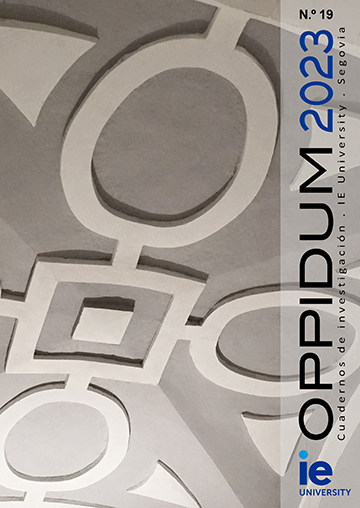

 |
 |
| NÚMERO ACTUAL | NÚMEROS ANTERIORES | ANEJOS Y OTROS | IE UNIVERSITY | |||
| SOBRE OPPIDUM | PRESENTACIÓN DE ORIGINALES | COMITÉ EDITORIAL | CONTACTO | |||
 |
GUIDELINES FOR
THE
SUBMISSION OF
MANUSCRIPTS AND
ETHICAL CODE NORMAS PARA LA PRESENTACIÓN DE ORIGINALES Y CÓDIGO ÉTICO [ESPAÑOL] 1.- Topics Oppidum. Cuadernos de investigación is a journal of annual periodicity published by the IE University Archeology Unit that compiles scientific studies related to topics of its curricular competence (Humanities, Social Sciences and Heritage Sciences). Anejos de Oppidum defines a collection of monographs of diverse periodicity dedicated to specialised studies in the different knowledge areas comprised in1 the IE University curricular scope, especially about Cultural Heritage and Archaeology. 2.- Structure Oppidum Journal consists of the following sections: 2.1.- Scientific papers Original scientific research works that successfully pass the journal external evaluation process. This format contains the vast majority of the journal contributions published. 2.2.- Research Notes and Book reviews The former collects brief studies whose results justify a concise publication. The section 'Book reviews' contains reviews of recently published books of especial interest concerning the disciplines and the journal fields of study. 3.- Drafting Guidelines Submissions should follow the following formal requirements. Only original and unpublished works will be accepted, written in Spanish or another modern scientific language. They must be written in Microsoft Word format as described in the template available in this link: [TEMPLATE]. Manuscripts should contain a maximum of 60.000 characters with spaces (or the equivalent of 25 DINA4 sheets, typography 11 pt, 2.0-spaced). Captions should not overpass 20% of the original total volume. Papers should include the title, specifying the authorship(s), scientific centre or institution affiliation and email contact(s). They should also contain an abstract, in Spanish or the drafting language, with keywords (a minimum of 4 and a maximum of 5) and a 100 words maximum length. Besides the title, abstract and keywords will be written in a second language, preferably English or Spanish, if the original written text displays a different language. The body of the text should include section headings to describe the work within a specific field of research, the applied methodology and the conclusions displayed clearly Captions and tables should be submitted individually, correctly numbered and entitled, placed in the better location of the text. They must take part in an adjoining reference list. When captions aren't original, they must reflect their correct citation. Footnotes with their relevant clarifications are welcome. According to the journal guidelines, In-text citations must include the name of the author(s) and publication year between parentheses, according to this format: According to the journal guidelines, In-text citations must include the name of the author(s) and publication year between parentheses, according to this format: (Blanco, 2005), (Casa/Domènech, 2014: 219) o (Arellano et al., 2015: fig. 6). Other standard formats are welcome. Finally, the paper must contain a section for listing references cited in the text in alphabetical and chronological order, with the author(s) name in small caps, according to the following examples: — Books: Arroyo, L. A. (1994): Alonso Fernández de Madrid, Arcediano del Alcor y la Silva palentina. Diputación Provincial de Palencia, Palencia. — Book Chapters: Reyes Hernando, O. V.; Pérez González, C. (2011): “Cauca: Arquitectura Monumental Tardoantigua”. En T. Nogales, I. Rodà (eds.), Roma y las provincias: modelos y difusión, Vol. II. Mérida, pp. 797-805. — Journal Papers: Larrañaga Zulueta, M. (2007): “Imagen, palabra y poder (siglos XI-XII)”. Oppidum. Cuadernos de investigación, 3, pp. 81-106. — Electronic Sources (Web Publications): Rodríguez Oliva, P. (2009): “Semblanza del Profesor Alberto Balil Illana (1928-1989)”. Biblioteca Virtual Miguel de Cervantes [en línea]. URL: <http://www.cervantesvirtual.com/nd/ark:/59851/ bmch99m5>. [Consulta: 19/5/2010]. 4.- Manuscript Submission Manuscripts should be submitted electronically, by email or digital storage devices, to the following address. We accept submissions via file hosting services (Wetransfer, Dropbox or similar): Revista Oppidum. Cuadernos de investigación IE Universidad, Unidad de Arqueología Campus de Santa Cruz la Real C/ Cardenal Zúñiga, 12 40003 Segovia Telephone No.: 921 415 337 / 921 412 410 Email: oppidum@ie.edu 5.- Ethical Code and revision process Oppidum. Cuadernos de investigación subscribes to the IE University Code of Ethical Conduct (https://www.ie.edu/es/ie-codigo-etico/ie-codigo-etico/), and the Committee on Publication Ethics-COPE Code of Conduct and the Best Practices Guidelines for Journals Editors (https://publicationethics.org/core-practices), of institutional and international scope, respectively. According to these criteria, original and unpublished manuscripts will be the object of publication only if they comply with the research ethic guidelines specified in the previous codes. To test the validity and originality of a paper, an antiplagiarism software tool (Turnitin) checks it. Afterwards, an external process review starts choosing peers from their accepted solvency criteria in the issue and their impartiality with the author and the content paper. The arbitration system employs a double-blind peer review, where the author(s) and the reviewer ignore their identities. Once the review process finishes, the author(s) will know the conclusions through the Editorial secretary. All originals that will not comply with the presentation guidelines or those not adjusted to journal quality demands, determined by the external review and the Editorial Board, will be rejected and returned to the author(s). Finalizado el proceso de evaluación se contactará con los autores del trabajo, informando de sus conclusiones a través de la Secretaría de la editorial. Tanto los originales que no cumplan las normas de presentación como los que no se ajusten a las exigencias de calidad determinadas por la revisión externa y el Consejo de Redacción serán desestimados y devueltos a sus autores. For those manuscripts accepted, the Executive Editorial Board reserves the right to publish, or not, submitted works and their partial or total reproduction, understanding that their content exclusively represents the author(s)’ personal opinion. |